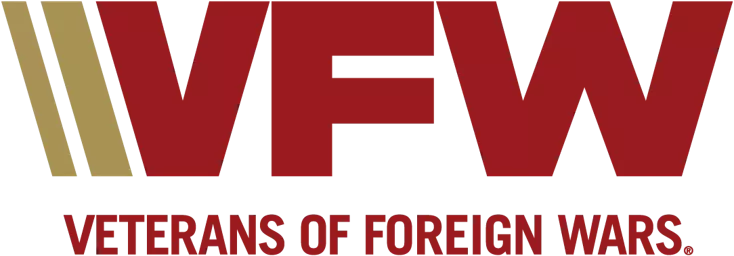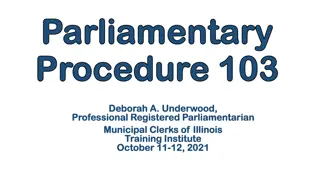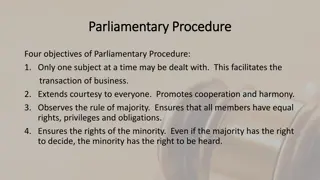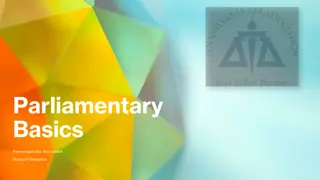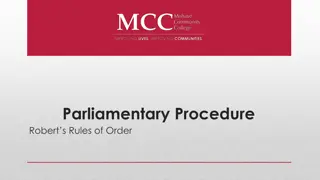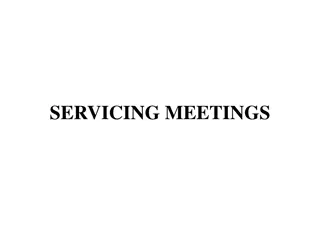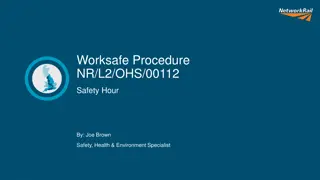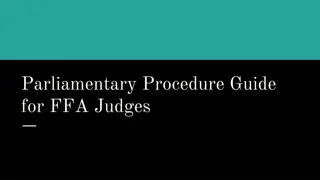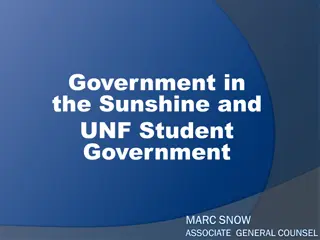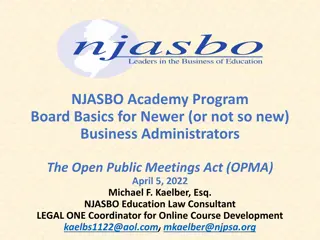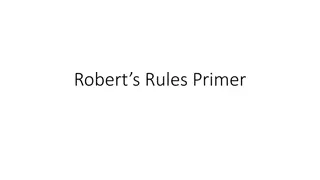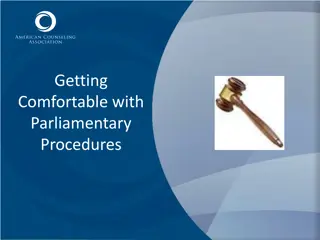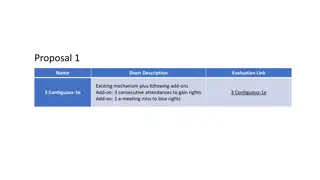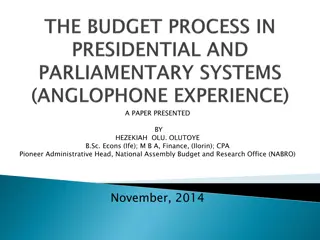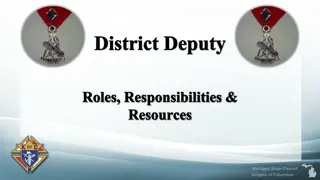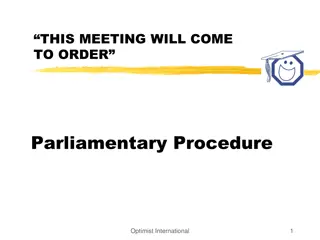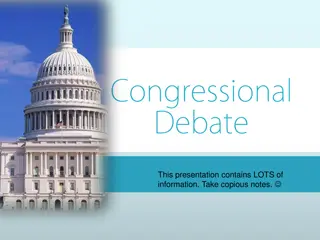Understanding Parliamentary Procedure for Effective Meetings
Parliamentary procedure is a set of rules and customs that govern meetings in various organizations. This system ensures fair and efficient decision-making by outlining the proper conduct of meetings, including making and handling motions, and the role of the presiding officer. By following parliamentary procedure guidelines, meetings can be conducted smoothly, allowing members to participate effectively and make informed decisions.
Download Presentation

Please find below an Image/Link to download the presentation.
The content on the website is provided AS IS for your information and personal use only. It may not be sold, licensed, or shared on other websites without obtaining consent from the author. Download presentation by click this link. If you encounter any issues during the download, it is possible that the publisher has removed the file from their server.
E N D
Presentation Transcript
PARLIAMENTARY PROCEDURE Johnathan R. Duncan Director, Administrative Operations Joshua N. Schreck VFW National Parliamentarian
VFW.org Training & Support The 2022 Podium Edition (Congressional Charter, Bylaws, Manual of Procedure, and Ritual) is now available; physical copies are available for purchase at the VFW Store and a digital copy may be downloaded behind the member login at VFW.org. The website section Member & Officer Training, Forms & Templates is now titled Bylaws: Training, Forms & Templates as this section now houses the digital copy of the 2022 Podium Edition available for download. Our Parliamentary Procedure Training video series is now available for view within the Bylaws: Training, Forms & Templates section of VFW.org. Given by VFW National Parliamentarian Joshua Schreck, these ten (10) short videos cover everything from how to make and handle motions to challenging announced results of a voice vote. 2
Note to Presiding Officers: The presiding officer is the servant of the organization. All his/her acts at meetings and conventions must have the body s approval, unless a bylaw makes them independent. Presiding officers who are ignorant of parliamentary law or who defy the body s will or deny to the members the proper exercise of their rights are a sad spectacle before intelligent assemblies and frequently cause discontent and disunity. Capable presiding officers make good meetings. Incompetent, abusive or obnoxious presiding officers can be censured; and their tenure of office can be shortened or abolished altogether by a 2/3 vote, and thus they may be legislated out of office at any meeting with prior notice. You are not expected to know all the law, but you are expected to be able to at least match the members combined basic knowledge of it.3
What is Parliamentary Procedure? Parliamentary procedure is the body of ethics, rules, and customs governing meetings and other operations of clubs, organizations, legislative bodies, and other deliberative assemblies. Our bylaws govern our proceedings and Section 1001 of our Manual of Procedure define our Rules of Order Governing All Meetings. As stated within this Section, any procedural matter not provided for within our bylaws are governed by Robert s Rules of Order Newly Revised. Our bylaws always take precedence. 4
What is Parliamentary Procedure? 5
Article X National Bylaws Section 1001 of the National Manual of Procedure are the Rules of Order that govern all meetings. Any procedural matter not provided for by this Section or Convention Rules shall be governed by the current Robert s Rules of Order, Newly Revised. Such rules may be altered or amended at any regular session of the body, upon proposition in writing, and by a majority vote of those present and voting. Any alteration or amendment of the rules provided herein shall be in accordance with procedures provided or permitted by Robert s. 6
Why Use Parliamentary Procedure? 1. Helps an organization achieve its purpose. 2. Provides equal treatment for all. 3. Expedites business and saves time. 4. Maintains order. 5. Protects the right of the majority to decide. 7
Why Use Parliamentary Procedure? 6. Protects the right of the minority to be heard. 7. Protects the rights of members. 8. Protects the rights of absentees. 9. Helps members understand the universal rules that are useful in any organization. 10. Makes for meetings that members want to attend. 8
Wheres the Agenda? A meeting without an agenda is an unproductive and aimless affair that will discourage even the most zealous member. When the chair calls the meeting to order an agenda, or order of business, is offered to the body (the membership) for approval. If no agenda or order of business is offered, ask for it. If certain points you are interested in do not appear to be included, rise and either inquire about them or MOVE to add them to the agenda. Once the agenda is approved, the meeting is limited to the points included. We usually take care of other matters (i.e. tensions and positives) under the good of the order. 9
Taking Care of Business Once the agenda, or order of business, has been adopted the business within the agenda may be taken up and moved forward. The business of a meeting is carried forward by motions. The object of all motions is to take up one item at a time and move the business forward by disposing of each item in an orderly and democratic manner. No member shall in debate impeach the motives of a fellow member or treat them with disrespect. Members shall avoid personal attacks and unbecoming speech. A member shall not pass between the speaker and the chair. Disruptive conduct shall be deemed a violation of order, and, if continued, the offending member shall be reprimanded by the presiding officer and may be ordered to retire from the room. Failure to comply with an order to retire may subject a member to disciplinary action for conduct prejudicial to the good order and discipline. 10
Taking Care of Business: Recognition In making a motion, or moving, the member should rise, face the chair, and signal or call for attention in a manner which will not disrupt the meeting. Once recognized by the chair, the speaker should first state his or her name and Post/District/Department, so such information can be recorded in the minutes. In other democratic bodies, it is proper to address the chair as Mr. Chairman or Madame Chair, but in the VFW it is proper to say Comrade Commander and offer a military salute in order to be recognized. Once a motion has been made, it is the duty of the chair to repeat it in order that everyone hears it, and also to clarify it, if it was made in confused language. 11
Taking Care of Business: Making Motions Once properly recognized by the Chair, a motion may be made. It is important the proposed motion is made in a clear and concise manner. The motion should be repeated and clarified by the Chair before being seconded. Correct: I move that (clear and plain language that is specific and limiting with a time constraint if necessary). Incorrect: (long drawn out explanation with no clear indication of where the motion starts and ends) I so move. 12
Taking Care of Business: Debating Motions Once a motion has been proposed, clarified by the Chair, and seconded, the motion may be debated or amended. While debating a motion, no member shall speak more than twice on the same question, nor longer than 10 minutes each time. No member shall speak a second time on the same question if any member who has not spoken on that question arises to claim the floor to speak thereon. Nominating speeches shall not exceed 5 minutes each, nor exceed two seconding speeches of two minutes each. 13
Taking Care of Business: Amending Motions Once a motion has been proposed, clarified by the Chair, and seconded, the motion may be debated or amended. The object of an amendment is to change or modify the original motion, without destroying the sense of it. For instance, if there was a motion on the floor to hold a picnic, it could be amended to add a date or a place, but it could not be amended to change the affair from a picnic to a bowling match. Amendments should take the form of: inserting or adding words to the motion; striking out words; substituting words or sentences. The chair is obliged to rule out of order any proposed amendment which would do more than the above, and change the sense of the motion entirely. 14
Taking Care of Business: Amending Motions (cont.) Amendments to motions are debatable (that is, can be discussed). Like motions, amendments also require seconding. Discussion on an amendment must be confined to the amendment itself. In taking the vote, after debate, the amendment is first voted upon, and then the motion itself is voted upon. Sometimes, the nature of the amendment is such that passing or defeating the amendment carries or defeats the motion also. In that event, it is not necessary to take a vote on the motion. 15
Taking Care of Business: Deferring Motions Once a matter has been duly placed on the floor through motion and seconded, it may become necessary to defer or postpone action. This can be done democratically by the assembly in several ways, in addition to withdrawing the motion, which we have already covered. Tabling: A motion to table is a motion to lay aside business in such a manner that it can be renewed at a later time either at the same meeting or a later one. A motion to table requires a second. Once seconded, the motion to table cannot be either debated or amended, but must be put to immediate vote without discussion. When it is desired to resume the matter which was tabled, the correct motion is to take from the table. This motion must be seconded, and is also not subject to debate or amendment. When a matter is taken from the table, it is taken with all previous actions, amendments, etc., and resumed just as it was when tabled. 16
Taking Care of Business: Deferring Motions (cont.) Tabling a motion or matter does not carry a time limit. That kind of postponement is handled as follows: Postpone to a Set Time: When the object is to set a future time at which a matter or motion must be considered, do not move to table. Instead, move to postpone to a set time, date, or meeting. A motion to so postpone consideration requires a second. It can be debated before being voted on, and can be amended as to the time. Place in Committee: When it is desired to let a few handle a given matter, instead of tying up the whole meeting needlessly, this is done by committing or placing in committee through a properly worded motion. Postpone Indefinitely: A motion to postpone indefinitely is really a motion to kill the subject. It must be seconded, can be debated, but cannot be amended. 17
Overruling the Chair The Chairman of a meeting or the Chair has certain rights, but they do not include engineering the meeting, or railroading certain matters through. A decision of the chair can always be subjected to change through appeal. When a member rises to appeal a decision of the chair, their motion can be either to appeal the decision, or to overrule the chair they both have the same meaning. Under such circumstances, the member should state carefully and in understandable language why he/she is making the motion. The motion requires a second. 18
Taking the Minutes The minutes of a meeting are simply a record of the proceedings of that particular meeting. As such, they can only be accepted by the body. In short, the general membership can only accept minutes of the membership meetings, the executive board can only accept its own minutes, etc. Upon reading of the minutes of a given meeting, they are subject to a motion to accept. Sometimes, corrections are raised, and then the minutes are accepted as corrected. Being simply the record of proceedings, minutes may be corrected at any time, including subsequent meetings. Minutes shall record all main motions which were not withdrawn, all points of order, all appeals and whether lost or sustained. The makers of motions should be recorded, but not necessarily the seconders. The date, time, and place of the meeting, as well as the time of adjournment should be in the minutes. Also the results of any roll call votes, and full report of tellers who tally ballots. 19
The Power of Collective Voice and Collective Genius When used correctly, parliamentary procedure is an effective tool to expedite the forward progress of a meeting; however, as with any tool parliamentary procedure can be misused. It s important to remember that this tool is to be used to benefit our society the VFW and never hinder its progress or forward momentum. As with all things we do in the VFW, we must always seek to understand first, in order to be better mentors, educators, and leaders rather than berate, reject, and dispel those who we do not understand or disagree with. 20
QUESTIONS? Johnathan R. Duncan Director, Administrative Operations Phone: 816.968.1133 Email: JDuncan@vfw.org Joshua N. Schreck VFW National Parliamentarian Phone: 716.364.2780 Email: JSchreck@vfw.org



